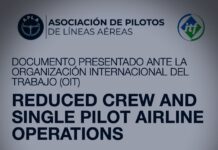IFALPA Position Statement: Use of accident related safety information
The IFALPA Executive Board notes that the provisions of ICAO Annex 13 are not consistently implemented around the world, causing some difficulty during and subsequent to the technical investigation. Further there is a mistaken belief amongst some IFALPA Member Associations that ICAO Annex 13 grants immunity from prosecution for pilots and that IFALPA supports this position. The purpose of this statement is to clarify IFALPAs understanding of the intent and scope of ICAO Annex 13.
IFALPA supports the proposition of Annex 13 that:
3.1 The sole objective of the investigation of an accident or incident shall be the prevention of accidents and incidents. It is not the purpose of this activity to apportion blame or liability.
It is important to note that this paragraph only refers to the investigation itself. It does not speak to other administrative or judicial action connected with an accident or incident. The real issue when dealing with such an administrative or judicial action is the use that may be made of the results of the investigation. IFALPA believes that many of the questions in this area may be resolved by application of Annex 13:
5.12 The State conducting the investigation of an accident or incident shall not make the following records available for purposes other than accident or incident investigation, unless the appropriate authority for the administration of justice in that State determines that their disclosure outweighs the adverse domestic and international impact such action may have on that or any future investigations: [emphasis added]
a) all statements taken from persons by the investigation authorities in the course of their investigation;
b) all communications between persons having been involved in the operation of the aircraft;
c) medical or private information regarding persons involved in the accident or incident;
d) cockpit voice recordings and transcripts from such recordings; and
e) recordings and transcriptions of recordings from air traffic control units; and
f) opinions expressed in the analysis of information, including flight recorder information.
IFALPA does not support the emphasised caveat in 5.12, but while it exists, IFALPA expects the caveat to be interpreted strictly by the applicable court or other authority.
The principles of the non-disclosure of records are amplified in Attachment E to Annex 13 which, while not a Standard, contains guidance material to assist States in amending their laws to allow safety programs generally and compliance with the provisions of the Annex, specifically those in paragraph 5.12. Relevant extracts of Attachment E are:
1.1 The protection of safety information from inappropriate use is essential to ensure its continued availability, since the use of safety information for other than safety-related purposes may inhibit the future availability of such information, with an adverse effect on safety.
c) inappropriate use refers to the use of safety information for purposes different from the purposes for which it was collected, namely, use of the information for disciplinary, civil, administrative and criminal proceedings against operational personnel, and/or disclosure of the information to the public.
2.2 It is not the purpose of protecting safety information to interfere with the proper administration of justice in States.
2.3 National laws and regulations protecting safety information should ensure that a balance is struck between the need for the protection of safety information in order to improve aviation safety, and the need for the proper administration of justice.
3. PRINCIPLES OF PROTECTION
3.5 The use of safety information in disciplinary, civil, administrative and criminal proceedings should be carried out only under suitable safeguards provided by national law.
4. PRINCIPLES OF EXCEPTION
Exceptions to the protection of safety information should only be granted by national laws and regulations when:
a) there is evidence that the occurrence was caused by an act considered, in accordance with the law, to be conduct with intent to cause damaqe, or conduct with knowledge that damage would probably result, equivalent to reckless conduct, gross negligence or wilful misconduct;
b) an appropriate authority considers that circumstances reasonably indicate that the occurrence may have been caused by conduct with intent to cause damage, or conduct with knowledge that damage would probably result, equivalent to reckless conduct,gross negligence or wilful misconduct; or
c) a review by an appropriate authority determines that the release of the safety information is necessary for the proper administration of justice, and that its release outweighs the adverse domestic and international impact such release may have on the future availability of safety information.
The intent of both paragraph 5.12 and the explanatory material in Attachment E is to ensure that the accident investigation has as much information available to it as possible to assess the factors behind an accident. For information such as witness statements to be given freely, the witnesses have to have confidence that these statements will not be used against them. It is obvious that there are situations where a pilot who for political or personal reasons deliberately crashes an aircraft, or has an accident while under the influence of drugs or alcohol, where prosecution is warranted. Typically the prosecution will proceed after the investigation has established that it was not in fact an accident but an intentional act. More controversially, there could be circumstances where a pilot was so reckless in his handling of a flight that an accident resulted. The test here would be should the pilot have known that by continuing the conduct harm would most probably have resulted? An example here would be taking-off and flying to a destination even though calculations reveal that there is most likely not enough fuel on board and subsequently running out of fuel and crashing after over flying alternates where more fuel was available.
None of these examples is exhaustive but the common element is that a pilot intended that an accident should happen, or should have known that by not doing something, or by doing something that an accident was likely to happen, even if he/she did not intend it. As a profession we are committed to promoting and maintaining the highest standards, and just as every other profession and employment is subject to legal sanction we should not seek to put pilots above the law under the circumstances just described. Otherwise, there is a real danger that the public and authorities will view the protections encompassed in Annex 13 and Attachment E, not as necessary safeguards to ensure that the lessons from an accident are learned and flight safety is improved, but as self-serving protections to put pilots above the law.
IFALPA always supports a comprehensive investigation of an accident where only the factors are listed and no blame is attached. However, when the accident investigation is complete, IFALPA recognises that the judicial and administrative authorities do have a right to bring prosecutions when there is evidence that the accident or incident was caused by conduct with intent to cause damage, or conduct with knowledge that damage would probably result, equivalent to reckless conduct, gross negligence or willful misconduct.
















